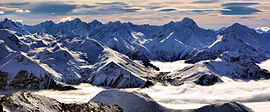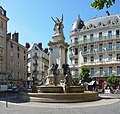Isère
Isère
Isera (Arpitan) Isèra (Occitan) | |
|---|---|
   | |
 Flag  Coat of arms | |
 Location of Isère in France | |
| Coordinates: 45°20′N 05°30′E / 45.333°N 5.500°ECoordinates: 45°20′N 05°30′E / 45.333°N 5.500°E | |
| Country | France |
| Region | Auvergne-Rhône-Alpes |
| Prefecture | Grenoble |
| Subprefectures | La Tour-du-Pin Vienne |
| Government | |
| • President of the Departmental Council | Jean-Pierre Barbier (LR) |
| Area | |
| • Total | 7,431 km2 (2,869 sq mi) |
| Elevation | 846 m (2,776 ft) |
| Highest elevation | 4,088 m (13,412 ft) |
| Lowest elevation | 134 m (440 ft) |
| Population (2016) | |
| • Total | 1,252,912 |
| • Rank | 16th |
| • Density | 170/km2 (440/sq mi) |
| Time zone | UTC+1 (CET) |
| • Summer (DST) | UTC+2 (CEST) |
| Department number | 38 |
| Arrondissements | 3 |
| Cantons | 29 |
| Communes | 512 |
| ^1 French Land Register data, which exclude estuaries and lakes, ponds and glaciers larger than 1 km2 | |
Isère (US: /iːˈzɛər/ ee-ZAIR,[1][2] French: [izɛʁ] (![]() listen); Arpitan: Isera; Occitan: Isèra) is a department in the Auvergne-Rhône-Alpes region in Southeastern France. Named after the river Isère, it had a population of 1,252,912 in 2016. Its prefecture is Grenoble.
listen); Arpitan: Isera; Occitan: Isèra) is a department in the Auvergne-Rhône-Alpes region in Southeastern France. Named after the river Isère, it had a population of 1,252,912 in 2016. Its prefecture is Grenoble.
History[]
Isère is one of the original 83 departments created during the French Revolution on 4 March 1790. It was established from the main part of the former province of Dauphiné.[3] Its area was reduced twice, in 1852 and again in 1967, on both occasions losing territory to the department of Rhône.
In 1852 in response to rapid urban development around the edge of Lyon, the (hitherto Isère) communes of Bron, Vaulx-en-Velin, Vénissieux and Villeurbanne were transferred to Rhône.[4] In 1967 the redrawing of local government borders led to the creation of the Urban Community of Lyon (more recently known simply as Greater Lyon or Grand Lyon). At that time intercommunal groupings of this nature were not permitted to straddle departmental frontiers, and accordingly 23 more Isère communes (along with six communes from Ain) found themselves transferred to Rhône. The affected Isère communes were Chaponnay, Chassieu, Communay, Corbas, Décines-Charpieu, Feyzin, Genas, Jonage, Jons, Marennes, Meyzieu, Mions, Pusignan, Saint-Bonnet-de-Mure, Saint-Laurent-de-Mure, Saint-Pierre-de-Chandieu, Saint-Priest, Saint-Symphorien-d'Ozon, Sérézin-du-Rhône, Simandres, Solaize, Ternay and Toussieu.
Most recently, on 1 April 1971, Colombier-Saugnieu was transferred to Rhône. Banners appeared in the commune's three little villages at the time proclaiming Dauphinois toujours ("Always Dauphinois").
Isère was also the name of the French ship which delivered the 214 boxes holding the Statue of Liberty.
Geography[]
Isère is part of the current region of Auvergne-Rhône-Alpes and is surrounded by the departments of Rhône, Ain, Savoie, Hautes-Alpes, Drôme, Ardèche and Loire.
Isère includes a part of the French Alps. The highest point in the department is the subpeak Pic Lory at 4,088 metres (13,412 ft), subsidiary to the 4,102 metres (13,458 ft) Barre des Écrins in the adjoining Hautes-Alpes department. The summit of La Meije at 3,988 metres (13,083 ft) is also well known. The Vercors Plateau aesthetically dominates the western part of the department.
Demographics[]
Inhabitants of the department are called Isérois (masculine) and Iséroises (feminine).
Population development since 1801:
| Year | Pop. | ±% p.a. |
|---|---|---|
| 1801 | 435,888 | — |
| 1806 | 471,660 | +1.59% |
| 1831 | 550,258 | +0.62% |
| 1841 | 588,660 | +0.68% |
| 1851 | 603,497 | +0.25% |
| 1861 | 577,748 | −0.44% |
| 1872 | 575,784 | −0.03% |
| 1881 | 580,271 | +0.09% |
| 1891 | 572,145 | −0.14% |
| 1901 | 568,693 | −0.06% |
| 1911 | 555,911 | −0.23% |
| 1921 | 525,522 | −0.56% |
| 1931 | 584,017 | +1.06% |
| 1936 | 572,742 | −0.39% |
| 1946 | 574,019 | +0.02% |
| 1954 | 626,116 | +1.09% |
| 1962 | 729,789 | +1.93% |
| 1968 | 768,490 | +0.86% |
| 1975 | 860,339 | +1.63% |
| 1982 | 936,771 | +1.22% |
| 1990 | 1,016,228 | +1.02% |
| 1999 | 1,094,006 | +0.82% |
| 2006 | 1,169,491 | +0.96% |
| 2011 | 1,215,212 | +0.77% |
| 2016 | 1,252,912 | +0.61% |
| source:[5] | ||
Politics[]
Departmental politics[]
The President of the Departmental Council has been Jean-Pierre Barbier of The Republicans (LR) since 2015.
Following the , the Departmental Council of Isère (58 seats) was composed as follows:
| Group | Seats | |
|---|---|---|
| • | The Republicans and allies | 26 |
| Socialist Party and allies | 13 | |
| • | Union of Democrats and Independents and allies | 5 |
| French Communist Party and allies | 5 | |
| Europe Ecology – The Greens and allies | 4 | |
| • | Independents | 3 |
| • | La République En Marche! | 2 |
Representation in Paris[]
National Assembly[]
In the 2017 legislative election, Isère elected the following representatives to the National Assembly:
Senate[]
In the 2017 Senate election, Isère elected Didier Rambaud (La République En Marche!), Guillaume Gontard (miscellaneous left), Frédérique Puissat (The Republicans), Michel Savin (The Republicans) and André Vallini (Socialist Party) for the 2017–2023 term.
Culture[]
The Grande Chartreuse is the mother abbey of the Carthusian order. It is located 22 km (14 mi) north of Grenoble.
As early as the 13th century, residents of the north and central parts of Isère spoke a dialect of the Franco-Provençal language called Dauphinois, while those in the Southern parts spoke the Vivaro-Alpine dialect of Occitan. Both continued to be spoken in rural areas of Isère into the 20th century.
Tourism[]
Isère features many ski resorts, including the Alpe d'Huez, Les Deux Alpes, the 1968 Winter Olympics resorts of Chamrousse, Villard de Lans, Autrans. Other popular resorts include Les 7 Laux, Méaudre, Saint-Pierre-de-Chartreuse, Alpe du Grand Serre and Gresse-en-Vercors.
Grenoble has a dozen museums, including the most famous created in Grenoble in 1798, the Museum of Grenoble.
It is the third largest ski and winter destination of France, after Savoie and Haute-Savoie, before Hautes-Alpes. It also hosts Coupe Icare, an annual festival of free flight, such as paragliding and hang-gliding, held at the world-renowned paragliding site at Lumbin.
Grenoble

The Grand Veymont

The Dent de Crolles

Queyras Valley
See also[]
- Cantons of the Isère department
- Communes of the Isère department
- Arrondissements of the Isère department
References[]
- ^ "Isère". The American Heritage Dictionary of the English Language (5th ed.). Boston: Houghton Mifflin Harcourt. Retrieved 22 August 2019.
- ^ "Isère". Merriam-Webster Dictionary. Retrieved 22 August 2019.
- ^ Frederick Converse Beach; George Edwin Rines (1912). The Americana: a universal reference library, comprising the arts and sciences, literature, history, biography, geography, commerce, etc., of the world. Scientific American compiling department. p. 741.
- ^ Revue du Lyonnais (in French). L. Boitel. 1865. p. 197.
- ^ Site sur la Population et les Limites Administratives de la France
- ^ http://www.assemblee-nationale.fr/
- Isère
- 1790 establishments in France
- Departments of Auvergne-Rhône-Alpes
- States and territories established in 1790








